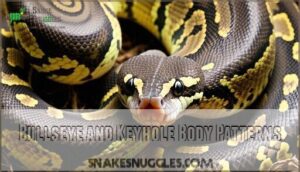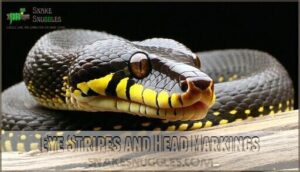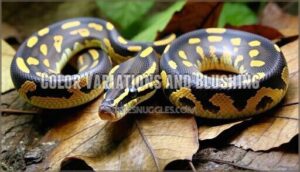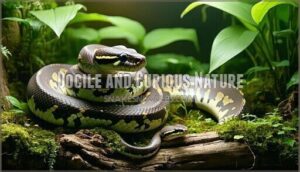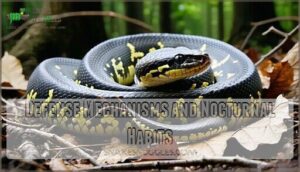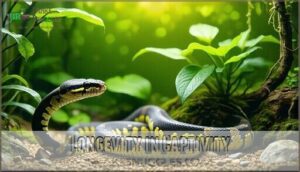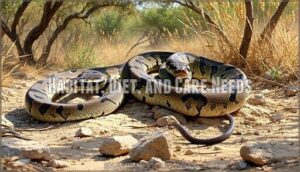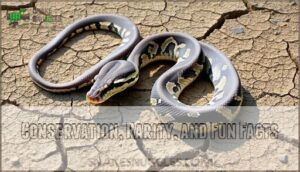This site is supported by our readers. We may earn a commission, at no cost to you, if you purchase through links.
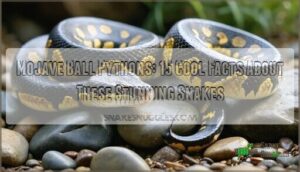 You’ll be amazed by these mojave ball pythons — 15 cool facts that showcase their remarkable genetics and beauty. Dan and Collette Sutherland created this co-dominant morph in 2000 from a single wild-caught snake. Their signature bullseye patterns and keyhole shapes make them instantly recognizable.
You’ll be amazed by these mojave ball pythons — 15 cool facts that showcase their remarkable genetics and beauty. Dan and Collette Sutherland created this co-dominant morph in 2000 from a single wild-caught snake. Their signature bullseye patterns and keyhole shapes make them instantly recognizable.
Breeding two Mojaves together produces Super Mojave offspring with even more striking features. These docile snakes live 20-30 years and use heat-sensing pits to hunt at night. They’re surprisingly rare in the wild but common in captivity.
The morph’s co-dominant genetics let you create designer combinations in just one generation. Their defensive curling behavior protects their heads when threatened, and their pattern development shows strong genetic influence that makes each snake unique.
Table Of Contents
- Key Takeaways
- Mojave Ball Python Origins and Genetics
- Distinctive Appearance and Coloration
- Behavior, Temperament, and Lifespan
- Habitat, Diet, and Care Needs
- Conservation, Rarity, and Fun Facts
- Frequently Asked Questions (FAQs)
- What is the typical lifespan of a mojave ball python?
- How can I tell if my mojave ball python is stressed or unhappy?
- How much does a Mojave ball python cost?
- What size tank does a Mojave need?
- Are Mojave ball pythons good for beginners?
- How often do Mojave ball pythons shed?
- Can Mojave ball pythons swim or climb?
- Conclusion
Key Takeaways
- You’ll discover Mojave ball pythons are co-dominant morphs created in 2000 that let you breed designer combinations in just one generation, making them genetic goldmines for creating stunning offspring like Super Mojaves and leucistics.
- You can expect a docile, curious companion that’ll live 20-30 years with proper care – these snakes curl into defensive balls when threatened and become active hunters at night using heat-sensing pits.
- You’ll recognize them instantly by their signature bullseye patterns and keyhole shapes with bright yellow eye stripes, though color intensity varies from bright golds to muted browns between individuals.
- You’ll find them surprisingly affordable at $80-$150 despite being extremely rare in the wild – they’re common in captivity but face conservation threats in their native African habitat.
Mojave Ball Python Origins and Genetics
You’ll discover that Dan and Collette Sutherland first developed the Mojave morph in 2000 using co-dominant genetics.
This means you can breed one Mojave parent with a normal ball python and get Mojave babies in the first generation.
History of The Mojave Morph
Back in 2000, Dan and Collette Sutherland made genetic breakthroughs that changed ball python breeding forever. Their Mojave morph development timeline started with one wild-caught snake from 1999. This single animal became the foundation for all early Mojave lines.
The Sutherlands’ discovery launched influential breeders into creating countless CoDominant combinations. Today’s ball python genetics owe everything to that original Mojave ball python morph. These snakes often exhibit reduced pattern variations.
Co-Dominant Genetic Traits
The Mojave’s co-dominant genetics create fascinating breeding outcomes. When you breed a Mojave ball python with a normal snake, roughly half the offspring display the Mojave morph. This CoDominant trait means visual variation appears in the first generation.
Breeding two Mojaves together produces Super Mojave offspring – a striking homozygous form. Ball python genetics make the Mojave morph incredibly valuable for creating designer combinations.
Role in Ball Python Breeding
Foundation builders, the Mojave morph revolutionized captive breeding when reptile breeders discovered its genetic goldmine. This co-dominant trait creates endless designer morphs through strategic genetic combinations, though breeding challenges arise with morph compatibility issues.
- Super Mojave combinations produce stunning leucistic offspring that’ll make your heart skip
- Pastel Mojave pairings create golden beauties that glow like sunshine
- Firefly crosses blend Mojave with Fire traits for jaw-dropping results
- Blue-eyed leucistics emerge from specific Mojave ball python combinations
- Future trends point toward even more exotic genetic combinations
Distinctive Appearance and Coloration
You’ll recognize a Mojave ball python instantly by its signature bullseye patterns and high-contrast coloration.
These co-dominant morphs show large round splotches with dark centers that create striking keyhole shapes along their bodies.
Bullseye and Keyhole Body Patterns
When you look at a Mojave ball python, you’ll notice their signature bullseye pattern immediately. These large, round splotches create distinct keyhole shapes across their body. Each spot features dark centers surrounded by lighter edges.
The Mojave morph produces outstanding pattern uniqueness compared to normal ball pythons. Spot size varies between individuals, but color intensity remains consistently high.
Pattern development shows strong genetic influence, making Mojave ball pythons instantly recognizable among snake enthusiasts.
Eye Stripes and Head Markings
Eye stripe variations make each Mojave ball python unique. These bright yellow markings frame their dark brown heads like racing stripes. The Mojave morph creates intense head pattern intensity that breeders love.
Here’s what makes their head markings special:
- Bright yellow eye stripes contrast sharply with dark brown heads
- Juvenile markings often show more vibrant coloration than adults
- Genetic influence creates consistent stripe placement across bloodlines
- Breeding impact allows breeders to select for enhanced head patterns
The Mojave pattern ensures these head markings stay bold and defined.
Color Variations and Blushing
Color intensity varies wildly across Mojave ball pythons. Some show bright golds while others display muted browns. You’ll notice greenish undertones in certain individuals. Genetic influence plays a big role in these traits.
Pattern aberrations create unique looks in each snake. Blushing extent differs too—some have minimal blushing while others show more.
| Trait | Description |
|---|---|
| Color Intensity | Ranges from bright golds to muted earth tones |
| Pattern Aberrations | Unique variations in standard bullseye patterns |
| Blushing Extent | Minimal to moderate color bleeding between patterns |
Behavior, Temperament, and Lifespan
You’ll find Mojave ball pythons are incredibly docile snakes that curl into tight balls when they feel threatened.
These hardy morphs can live 20-30 years in captivity and stay active mostly at night when they hunt for food.
Docile and Curious Nature
Most Mojave ball python owners discover their snake’s gentle personality within days of bringing them home. These Python regius morphs have incredibly docile temperaments that make handling benefits obvious. Your Mojave morph will show curiosity about new environments and rarely display aggression.
Regular interaction frequency helps build trust, though temperament changes are minimal since they’re naturally calm. Considering that genetics influence temperament, breeders often select for calmness.
While training potential is limited, enrichment needs include varied hiding spots to stimulate their inquisitive nature.
Defense Mechanisms and Nocturnal Habits
When darkness falls, your Mojave ball python becomes a different snake entirely. These nocturnal hunters use fascinating defense mechanisms that make them unique among reptiles.
Here are 5 key behaviors you’ll observe:
- Defensive Curling – They roll into tight balls when threatened, protecting their heads inside their coiled bodies
- Nocturnal Hunting – Most active after sunset, using heat-sensing pits to locate prey in complete darkness
- Solitary Behavior – Prefer living alone, only seeking companionship during breeding season
- Hiding Preferences – Spend daylight hours burrowed under logs, rocks, or in abandoned burrows
- Crepuscular Activity – Show peak movement during twilight hours when shifting between day and night modes
This body pattern adaptation helps wild Mojave morphs blend perfectly with shadowy environments.
Longevity in Captivity
Your Mojave ball python can be your companion for decades. These snakes live 20-30 years in captivity when you provide proper care. Good husbandry practices matter more than genetic predisposition for longevity. Reptile breeders know that enrichment impact and preventing common ailments extend lifespan substantially.
| Captive Lifespan Factors | Years Added/Lost |
|---|---|
| Proper husbandry practices | +5-10 years |
| Poor diet and temperatures | -10-15 years |
| Regular vet checkups | +3-5 years |
| Genetic predisposition issues | -2-5 years |
Habitat, Diet, and Care Needs
You’ll need to understand your Mojave’s natural habitat to create the right setup at home.
These morphs come from African savannas where they hunt small rodents and need warm temperatures with hiding spots.
Natural Habitat and Geographic Distribution
Ball pythons call western and central Africa home. You’ll find them across grasslands, savannas, and sparse forests near water sources. Countries like Nigeria, Ghana, and Senegal host large populations.
These African ecosystems face habitat threats from human development. Distribution factors include water access and prey availability. Regional variations exist across their range.
The wild diet consists of small rodents and birds. The wildtype ball python’s body pattern helps it blend into natural surroundings.
Enclosure Setup and Environmental Requirements
Setting up your Mojave ball python’s home requires attention to detail. These stunning morphs thrive when you create the right environment. Here’s what reptile breeders recommend:
- Temperature gradients from 78-80°F cool side to 88-92°F warm side
- Humidity control between 50-60% with occasional spikes to 70%
- Substrate choices like cypress mulch or paper towels work well
- Enclosure size minimum 40 gallons for adults, 75+ gallons preferred
- Lighting needs are minimal since they’re nocturnal creatures
Your exotic pet trade investment deserves proper care; selecting the right python enclosure products is vital for their well-being.
Feeding and Nutrition
When feeding your Mojave ball python, offer frozen-thawed prey that matches their girth. Adults eat every 2-3 weeks, while juveniles need weekly meals. Most reptile breeders avoid live feeding due to injury risks.
Your morph doesn’t need nutritional supplements with whole prey. The exotic pet trade has made proper ball python nutrition straightforward and safe.
It’s important to thaw frozen prey to the correct temperature before feeding.
Conservation, Rarity, and Fun Facts
You’ll find some surprising truths about Mojave ball pythons that might change how you view these popular morphs. While they’re common in the pet trade at $80-$150 each, wild Mojaves are extremely rare due to habitat loss and the species’ near-threatened conservation status.
Conservation Status and Pet Trade Impact
Unfortunately, ball pythons face serious Wild Population Threats. The IUCN lists their conservation status as Near Threatened since 2012. The exotic pet trade exports millions yearly from Africa. Wild Mojave morph discoveries remain extremely rare.
Responsible Ownership and Sustainable Breeding by reptile breeders help. Conservation Efforts push for Ethical Pet Trade practices to protect declining populations. The capture and captivity of these snakes causes enormous suffering and cruelty.
Rarity in The Wild Vs. Captivity
Here’s a wild fact: Mojave ball pythons are extremely rare in their natural habitat but common in captivity. Wild population decline affects the Ball Python Morph globally, while captive breeding programs sustain availability. You’ll find Mojave morphs easily through ethical sourcing from dedicated breeders.
Conservation efforts focus on maintaining genetic diversity in breeding lines, making this ball python accessible despite conservation status concerns. Some programs focus on captive viper breeding to preserve endangered species.
Unique Facts and Popular Designer Morphs
The Mojave ball python paves the way to endless Designer Mojave Morphs through strategic Genetic Combinations. You’ll find Super Mojave specimens displaying stunning leucistic qualities with bold Unique Pattern Variations.
Popular Ball Python Morph combinations include Pastel Mojave, creating vibrant golden hues, and Firefly Mojave variants. These Rare Mojave Traits make the Mojave Popularity Factors clear—they’re breeding goldmines for creating breathtaking designer combinations.
Many owners purchase supplies for Mojave ball pythons online.
Frequently Asked Questions (FAQs)
What is the typical lifespan of a mojave ball python?
Twenty to thirty years in captivity—that’s a serious commitment! You’ll watch your Mojave morph grow from hatchling to adult over decades.
These pythons are marathon pets, not sprints. Their longevity makes them excellent breeding stock for multi-generational projects.
How can I tell if my mojave ball python is stressed or unhappy?
Watch for defensive ball posturing, reduced appetite, excessive hiding, and irregular shedding patterns. Stressed snakes often refuse food and stay hidden constantly. Check your temperature gradients and humidity levels first.
How much does a Mojave ball python cost?
Sarah’s first snake cost her $120 at a reptile expo last month. These morphs are common in the pet trade, making them affordable starter snakes for new keepers. You’ll usually pay $80-$150 for a single Mojave ball python.
What size tank does a Mojave need?
You’ll need a 50-60 gallon tank minimum for your adult Mojave. That’s roughly 4 feet long, 2 feet wide, and 1 foot tall. This gives them enough space to stretch out comfortably.
Are Mojave ball pythons good for beginners?
You’ll find Mojave ball pythons perfect for beginners. They’re docile, hardy, and curious snakes that handle well. Their gentle temperament makes them safe and manageable for new keepers starting out.
How often do Mojave ball pythons shed?
Your Mojave ball python will shed every 4-8 weeks when young, then every 2-4 months as an adult.
You’ll notice their skin getting cloudy and eyes turning blue before shedding begins.
Can Mojave ball pythons swim or climb?
Like water through a net, these snakes surprise you with their swimming skills. **Your Mojave isn’t just a floor-hugger.
**
Ball pythons are excellent swimmers and climbers, despite being a large snake that’s usually found on land, letting them hunt effectively in nature.
Conclusion
You can’t put the genie back in the bottle in regards to these mojave ball pythons and the 15 cool facts we’ve covered. These co-dominant morphs changed snake breeding forever.
Their bullseye patterns and gentle nature make them perfect pets. You’ll find endless breeding possibilities with Super Mojaves and designer combos.
Whether you’re starting your collection or expanding it, Mojaves offer beauty and genetics that keep surprising breeders worldwide.

